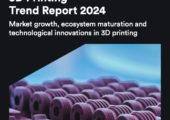
More 3D printing moving beyond prototyping to production: survey
By DE Staff
Additive Manufacturing MaterialsThe newly published 3D Printing Trend Report provides a snapshot of the additive manufacturing industry and highlights emerging trends as applications for 3D printing’s continued growth.
Protolabs’ annual report shows that 3D printing is steadily moving beyond prototyping towards production-level manufacturing. It reveals a steady growth in production-run volumes. Respondents who said they printed more than 10 parts rose from 36 per cent in 2020, to 49 per cent in 2021 and to 76 per cent in 2023.
The mindset around additive and production is slowly changing as well. Forty-five per cent of survey respondents named production volume and scale as a factor for choosing other manufacturing methods over 3D printing—down from 47 per cent the previous year.
Through key market data and a survey of more than 700 members of the global engineering community, the report depicts a healthy level of confidence in the 3D printing market. The 2024 3D-printing market size is estimated at US$28.1 billion—and estimated to reach US$57.1 billion by the end of 2028.
The report also found the expansion of available materials and related technologies will play a vital role in shaping future use cases. For example, nearly a third of respondents reported multi-material printing will have the biggest impact on 3D printing growth, second only to hybrid manufacturing, which combines additive technology with traditional services.
As the excitement of AI permeates almost every sector, 3D printing is no exception. The report reveals the big promise of an AI-disrupted industry has yet to be fully realized, but smart printers are getting smarter and improving the user experience. Nearly a third of respondents identified automated print tuning as the top impact from AI. Design for additive manufacturing will also benefit from AI innovations—think topology optimization, multiphysics process simulation and AI-generated CAD.
 To find out more about the status of additive manufacturing—broken down by industry and region—and where 3D printing is heading next, download the full report.
To find out more about the status of additive manufacturing—broken down by industry and region—and where 3D printing is heading next, download the full report.
Print this page
Advertisement
<
